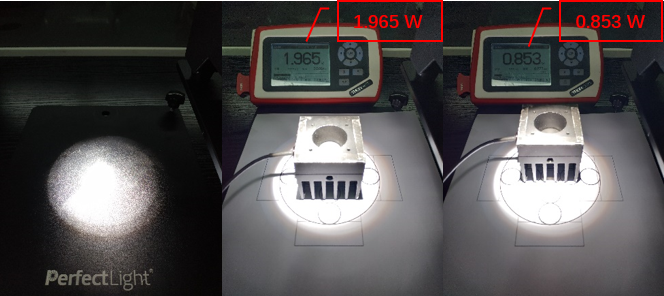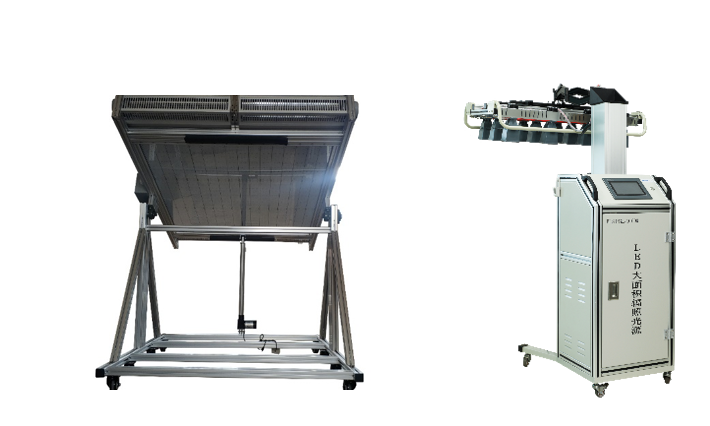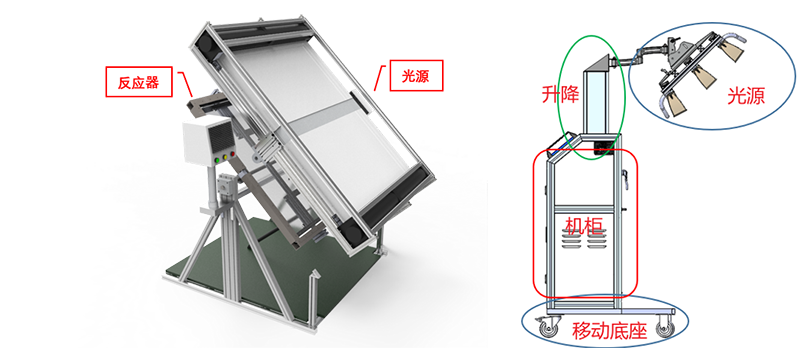In the previous article, it was mentioned that when choosing a light source for photocatalytic experiments, factors such as light intensity, light source stability, and light spot uniformity need to be considered. Xenon lamp light sources are the closest to solar spectra, but in photochemical experiments, xenon lamp light sources cannot meet the requirements for large-area irradiation. With the gradual deepening of the concept of "hydrogen farm[1]" and the improvement of photocatalyst efficiency in photocatalytic water splitting for hydrogen production[2], photocatalytic hydrogen production equipment has also begun to move from laboratory experiments towards small-scale production.
During the laboratory phase, the reactor for photocatalytic hydrogen production had a light area of only 40 cm2, and the light spot size of the xenon lamp light source could meet the requirements. However, in the small-scale production phase, the size of the reactor for photocatalytic hydrogen production is no longer limited to 40 cm2; it requires square meters of reactors. At this point, the light spot size of the xenon lamp light source cannot meet the production requirements.
Firstly, the xenon lamp light source directly outputs an uneven light spot, with the central area being stronger, gradually decreasing in light intensity as it spreads outward from the center, as shown in Figure 1.

Figure 1: Comparison of Xenon Lamp Light Spot Physical Image and Measured Light Power at the Center and Edge Positions of the Light Spot
Secondly, xenon lamp light sources are thermal light sources and generate high heat during operation, which not only directly affects the lifespan of the xenon lamp bulb but also causes thermal effects on the materials being irradiated. To address the issue of heat, xenon lamp light sources typically require multiple heat dissipation components and light-filtering structures. Therefore, large-area xenon lamp light sources usually have larger volumes. When there is a demand for large-area irradiation, such as using multiple xenon lamp light sources together, it places significant demands on the experimental space and power supply.
Due to the constraints of light spot characteristics and equipment size factors, xenon lamp light sources cannot be used in experiments requiring large-area irradiation. To address the issue of large-area irradiation light sources, Perfectlight Technology uses LEDs as the light-emitting source and has developed two different large-area irradiation light sources for different experimental scenarios: PLS-DPCR-1.0 square meter-scale photocatalytic reaction demonstration equipment and PLS PGL-O1000 LED Large-Area Irradiation Light Source.

Figure 2: PLS-DPCR-1.0 Square Meter-Scale Photocatalytic Reaction Demonstration Equipment and PLS PGL-O1000 LED Large-Area Irradiation Light Source
When xenon lamp light sources cannot be used for large-area irradiation experiments, the reason for choosing LED as the light-emitting source is primarily because LED light sources are cool light sources with very little heat output, and their heat dissipation components are also small in size. Secondly, LED light sources have a single light-emitting chip as the light source, which can be integrated into different structures according to the usage scenario, such as a surface array light-emitting body, flexible light strip, rigid light bar, and so on. Additionally, LED light sources can output narrow-band wavelengths and simulate solar spectrum and other special requirements through multiple light-emitting chips.
In the context of the "double carbon" initiative, hydrogen energy, as a carbon-free renewable clean energy source, has received attention. Photocatalytic water splitting for hydrogen production is one of the important methods for producing hydrogen gas.
PLS-DPCR-1.0 square meter-scale photocatalytic reaction demonstration equipment is mainly used for close-range irradiation experiments on large areas of 5~10 cm. It has a radiation area of 1×1 m2 and outputs a light irradiance of 300 mW/cm2 within the working distance, simulating solar spectra with uniformity of 90%. It is equipped with a 1×1 m2 flat plate reactor for photocatalytic hydrogen production experiments, and the flat plate reactor has a gas collection structure and measures gas production rates using mass flowmeters.

Figure 3: PLS-DPCR-1.0 Square Meter-Scale Photocatalytic Reaction Demonstration Equipment and PLS PGL-O1000 LED Large-Area Irradiation Light Source Schematic
Photocatalytic degradation includes research directions such as photocatalytic degradation of organic pollutants, photocatalytic degradation of VOCs, photocatalytic wastewater treatment, and photocatalytic sterilization. In the context of the ongoing pandemic prevention and control both domestically and internationally, methods for sterilization using photocatalysis have gained attention. Photocatalysts produce active groups after exposure to light, which can kill bacteria or viruses, achieving the goal of large-area sterilization and disinfection.
PLS PGL-O1000 LED Large-Area Irradiation Light Source is mainly used for large-area spatial irradiation and can be used in the field of large-area photocatalytic sterilization research, such as laboratory benches, analytical laboratory countertops, corridors, hospital wards, and other applications that require large-area light disinfection and sterilization. Under standard working conditions, the light source angle is adjustable to meet different angle illumination requirements such as horizontal, inclined, and vertical. The average irradiance is ≥9 mW/cm², and the uniformity is ≥80%. It comes with bottom rollers for easy mobility and storage. The LED light source can be equipped with light chips of different wavelengths to meet different wavelength application scenarios.
The spectral and optical power of xenon lamp light sources and LED light sources mentioned above can be customized as needed. If you have any requirements for experimental light sources, please feel free to contact us through the website.
[1] Zhao Yue, Li Rengui*, Li Can*, et. al. A hydrogen farm strategy for scalable solar hydrogen production with particulate photocatalysts[J]. Angew, 2020, 132(24), 9740.
[2] Zhao Daming, Guo Liejin, Shen Shaohua*, et. al. Boron-doped nitrogen-deficient carbon nitride-based Z-scheme heterostructures for photocatalytic overall water splitting[J]. Nature Energy, 2021, 6, 388.